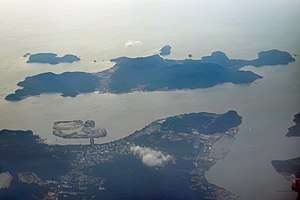Pangkor Island
Pangkor Island (Malay: Pulau Pangkor) is a resort island in Manjung District, Perak, Malaysia. It has a population of approximately 25,000. Nearby islands include Pangkor Laut Island, Giam Island,[1] Mentagor Island, Simpan Island, and Tukun Terindak Island. The major industries of the island are tourism and fishing.
| Native name: Pulau Pangkor ڤولاو ڤڠكور 邦咯島 | |
|---|---|
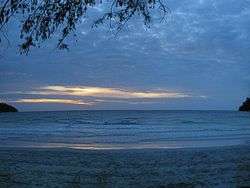 Sunset at a beach of Pangkor | |
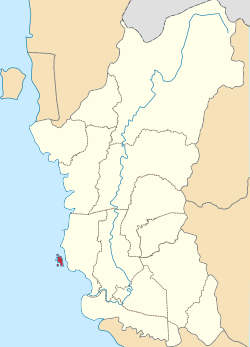 | |
 Pangkor | |
| Geography | |
| Location | Strait of Malacca |
| Coordinates | 4°13′12″N 100°33′18″E |
| Area | 18 km2 (6.9 sq mi) |
| Administration | |
| State | Perak |
| District | Manjung |
| Demographics | |
| Population | 25,000 |
| Ethnic groups | Malay, Chinese |
Geography
Pangkor Island has a land area of 18km2[2] and is 3.5 kilometres (2.2 mi) from Peninsular Malaysia. The interior of the island is forested and is home to 65 reptile species, 17 amphibian species, and 82 total herpetofaunal species.[2]
History
.jpg)
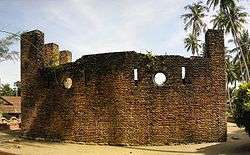
Historically, Pangkor was a refuge for local fishermen, merchants and pirates. In the 17th century, the Dutch built a fort to control the Perak tin trade known as the Dutch Fort. In 1874, it was the location of a historical treaty between the British government and a contender for the Perak throne (the Pangkor Treaty), which began the British colonial domination of the Malay Peninsula. The old British name for the Pangkor Island group was the Dindings.[3]
In 2003, Marina Island (a man-made island) was developed by the Marina Island Group of companies and began operation in 2010, with private investment of 250 million ringgit million by 2013. The integrated mixed development resort island consists of waterfront residential properties, a new jetty (Marina Island Jetty), a private commercial marina called Pangkor Marina Malaysia, service apartments, hotels and shop offices. The jetty has a ferry service which connects to the island.
2004-2014 was a period of high growth and development for the island and the surrounding district.[4] In 2006, a biotechnology centre, a joint venture of Global Hi-Q Malaysia S/B and Hi-Q Bio-Tech International (Taiwan) Ltd began operations with initial investments of 100 million ringgit (USD 30 million). Their operations include fish farming and aquaculture, and the first harvest was expected in 2009.
On 19 February 2010, the Sultan of Perak, Sultan Nazrin Shah, visited the island.
Tourism
Following the Government move to grant the island duty-free status effective 1st January 2020, the island recorded a 40 percent increase in visitors. Manjung Municipal Council (MPM) recorded 1.42 million visitors to the island compared to 1.03 million in 2017.[5]
Transport
Pangkor Island is a three-hour drive from Kuala Lumpur[6] and is accessible through the Simpang Pulai–Lumut 4-lane dual carriage highway and the West Coast Expressway. Buses arrive frequently at the main jetties in Lumut. There are no bridges connecting the island to the mainland because a policy exists to control the number of vehicles on the island to prevent road congestion. There are no public bus services to the Marina.
Public ferries depart from Lumut to Pangkor Island from the old Lumut jetty. The ferry service stops at two jetties at the east side of Pangkor Island, Sungai Pinang Kecil; SPK jetty; and at Pangkor Town Jetty.
The island is served by Pangkor Airport, although there is no scheduled airline service. Charter air service is offered by Berjaya Air.
Notable places
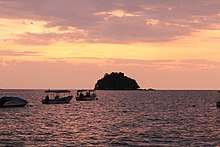
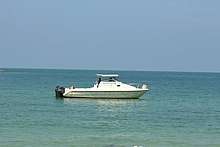
The west coast of Pangkor is famous for its beaches, resorts and hotels for tourist accommodations. The popular beaches there include Pasir Bogak, Teluk Nipah and Coral Beach. The east coast of Pangkor is where all the local residents live, and where many of them work in the local foods and fisheries activities, including the dry fish factory, boat workshops, and a fish farm. Other attractions on the island include the Fu Ling Kong temple, the Sri Pathirakaliamman temple in Sungai Pinang Besar village; Batu Bersurat, Tiger Rock, the Dutch Fort (Kota Belanda), the tombs in Kampung Teluk Gedung and Tortoise Hill.
References
- United States. Hydrographic Office (1917). Asiatic Pilot: The coasts of Sumatra and the adjacent straits and islands. Retrieved 15 June 2014.
- Johan van Rooijen; Chan Kin Onn; L. Lee Grismer; Norhayati Ahmad. "Estimating the herpetofaunal species richness of Pangkor Island, Peninsular Malaysia" (PDF). Netherlands Centre for Biodiversity Naturalis, section Zoological Museum Amsterdam. Retrieved 15 June 2014.
- Moore, Wendy. West Malaysia and Singapore. Retrieved 15 June 2014.
- "High growth in district over the last 10 years". The Star. Retrieved 15 June 2014.
- Calvin Yap (30 September 2019). "Sustaining Pangkor's growth momentum". The Star. Retrieved 30 September 2019.
- "Places to go for day trippers". The Rakyat Post. Retrieved 15 June 2014.
Climate
Pangkor Island is situated off the west coast of Malaysia and experiences hot and humid weather all year round. The rainy season runs from April - October and the dry season is from October - April.
External links
| Wikimedia Commons has media related to Pangkor Island. |
| Wikivoyage has a travel guide for Pangkor Island. |
